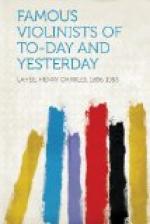As the art of violin making developed, so did that of violin playing, but, whereas the former reached its climax with Stradivari, the latter is still being developed, as new writers and players find new difficulties and new effects. While there are many proofs that orchestras existed, and that violins of all sizes were used in ecclesiastical music, there is still some doubt as to who was the first solo violinist of eminence. The earliest of whom we have any account worthy of mention, was Baltazarini, a native of Piedmont, who went to France in 1577 to superintend the music of Catharine de Medici. In 1581 he composed the music for the nuptials of the Duke de Joyeuse with Mlle. de Vaudemont, sister of the queen, and this is said to have been the origin of the heroic and historical ballet in France.
The progress of violin playing can also be judged somewhat by the compositions written for the instrument. Of these the earliest known is a “Romanesca per violone Solo e Basso se piaci,” and some dances, by Biagio Marini, published in 1620. This contains the “shake.” Then there is a “Toccata” for violin solo, by Paolo Quagliati, published in 1623, and a collection of violin pieces by Carlo Farina, published in 1627 at Dresden, in which the variety of bowing, double stopping, and chords shows a great advance in the demands upon the execution.
Farina held the position of solo violinist at the Court of Saxony, and has been called the founder of the race of violin virtuosi. One of his compositions, named “Cappriccio Stravagante,” requires the instrument to imitate the braying of an ass, and other sounds belonging to the animal kingdom, as well as the twanging of guitars and the fife and drum of the soldier.
Eighteen sonatas composed by Giovanni Battista Fontana, and published at Venice in 1641, show a distinct advance in style, and Tomasso Antonio Vitali, himself a famous violinist, wrote a “Chaconne” of such merit that it was played by no less a virtuoso than Joachim, at the Monday popular concerts in London, in 1870, nearly two hundred years after its composition.
Italy was the home of the violin, of composition for the violin, and of violin playing, for the first school was the old Italian school, and from Italy, by means of her celebrated violinists, who travelled and spread throughout Europe, the other schools were established.
Violin playing grew in favour in Italy, France, Germany, and England at about the same time, but in England it was many years before the violinist held a position of any dignity. The fiddle, as it was called, was regarded by the gentry with profound contempt. Butler, in “Hudibras,” refers to one Jackson, who lost a leg in the service of the Roundheads, and became a professional “fiddler:”
“A squeaking engine he apply’d
Unto his neck, on northeast side,
Just where the hangman does dispose,
To special friends, the knot or noose;
For ’tis great grace, when statesmen
straight
Dispatch a friend, let others wait.




